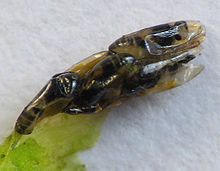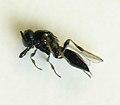| Platygastridae | |
|---|---|
 | |
| Platygaster pupae inside gall | |
| Scientific classification | |
| Kingdom: | Animalia |
| Phylum: | Arthropoda |
| Class: | Insecta |
| Order: | Hymenoptera |
| Superfamily: | Platygastroidea |
| Family: | Platygastridae Haliday, 1833 |
| Subfamilies | |
| Platygastrinae | |
The hymenopteran family Platygastridae (sometimes incorrectly spelled Platygasteridae) is a large group (over 4000 species) of exclusively parasitoid wasps, mostly very small (1–2 mm), black, and shining, with elbowed antennae that have an eight-segmented flagellum. The wings sometimes lack venation, though they may have slight fringes of setae.
The traditional subfamilies are the Platygastrinae and the Sceliotrachelinae. The former subfamily includes some 40 genera, all of which are koinobionts on cecidomyiid flies; the wasp oviposits in the host's egg or early instar larva, and the wasp larva completes development when the host reaches the prepupal or pupal stage. The latter subfamily is much smaller, including some 20 genera, and they typically have the rudiments of a vein in the forewings. They are generally idiobionts, attacking the eggs of either beetles or Hemiptera.
The former family Scelionidae is now considered to be another subfamily of Platygastridae, along with the subfamilies Teleasinae and Telenominae. The oldest known record of the group is an indeterminate specimen from the Burmese amber.[1]
Sceliotrachelinae
Sceliotrachelinae includes the genus Aphanomerus, which includes a number of species: [2][3]
- Aphanomerus aureus (Dodd, 1914)
- Aphanomerus bicolor (Perkins, 1905)
- Aphanomerus flavus (Dodd, 1914)
- Aphanomerus niger (Perkins, 1905)
- Aphanomerus nigriceps (Dodd, 1914)
- Aphanomerus pusillus (Perkins, 1905)
- Aphanomerus rufescens (Perkins, 1905)
- Aphanomerus sordidus (Dodd, 1914)
Aphanomerus pusillus, a wasp native to Queensland, Australia, has proven effective against the "pandanus planthopper", or Jamella australiae, which has decimated populations of Pandanus tectorius along the coasts of northern New South Wales and Queensland.[4][5]
References
- ^ Talamas, Elijah J.; Johnson, Norman F.; Shih, Chungkun; Ren, Dong (2019-11-18). "Proterosceliopsidae: A new family of Platygastroidea from Cretaceous amber". Journal of Hymenoptera Research. 73: 3–38. doi:10.3897/jhr.73.32256. ISSN 1314-2607.
- ^ "Genus: Aphanomerus". Aphanomerus. Retrieved 4 January 2021.
- ^ Stünzner, Inga (15 December 2020). "Byfield National Park becomes last line of defence against threat to pandanus". ABC News. Australian Broadcasting Corporation. Retrieved 4 January 2021.
- ^ "The insects killing Fraser Island's pandanus population". Queensland Times. 26 January 2017. Retrieved 4 January 2021.
- ^ Coghill, Jon (29 October 2015). "Rangers turn to tiny native wasp to save Fraser Island's iconic pandanus population". ABC News. Australian Broadcasting Corporation. Retrieved 4 January 2021.
- Peter N. Buhl and David G. Notton, 2009 A revised catalogue of the Platygastridae of the British Isles Journal of Natural History Vol. 43, Nos. 27-28,1651-1703 [1]
External links
- a citrus blackfly parasitoid, Amitus hesperidum on the UF / IFAS Featured Creatures Web site
- Baeus latrodecti Dozier on the UF / IFAS Featured Creatures Web site


